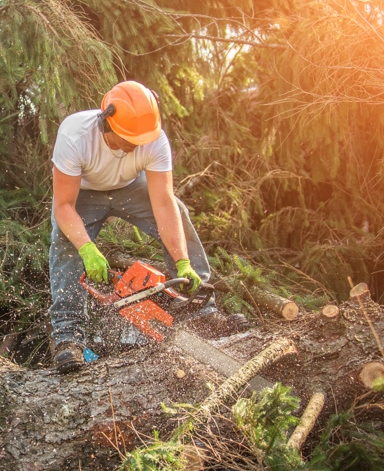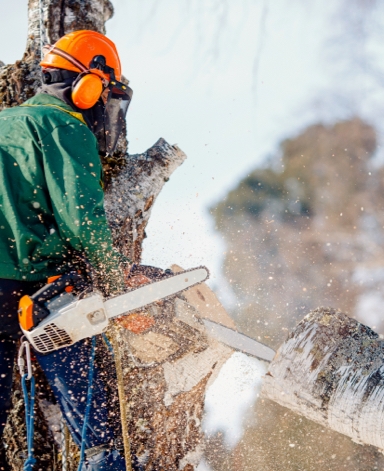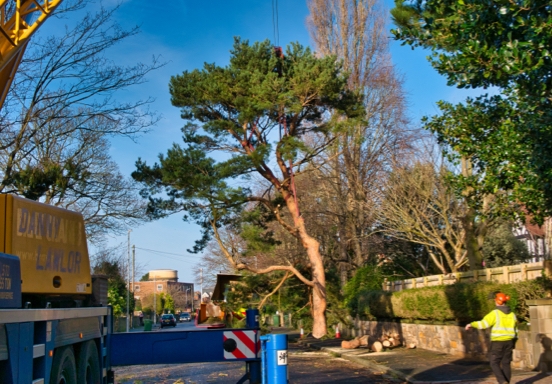WHAT IS CROWN THINNING
A crown lift refers to the process by which we remove the lowest hanging branches on the crown of the tree. This can be requested for a number of reasons.
Crown thinning is a pruning technique that involves removing branches from the interior of a tree's crown to improve its health, safety, and appearance. It is an important aspect of tree maintenance that should only be performed by a qualified and experienced tree surgeon.
The main goal of crown thinning is to reduce the density of a tree's foliage, which can be accomplished by carefully removing branches that are crossing, competing, diseased, or otherwise reducing the tree's overall health. This helps to increase air and light penetration, allowing for greater photosynthesis and improved overall health of the tree. Crown thinning also reduces the weight of the tree's crown, which can make it less likely to be damaged by wind or other factors.
In addition to improving the health and safety of a tree, crown thinning can also enhance its appearance. By removing specific branches, a tree surgeon can create a more uniform and attractive shape for the tree. This can be especially important for trees that are located near buildings, sidewalks, or other structures, as a well-maintained tree can add to the aesthetic appeal of a property.
When performed properly, crown thinning is a safe and effective way to maintain the health and beauty of a tree. However, it is important to note that over-thinning a tree can have the opposite effect, causing it to become weakened and more vulnerable to disease and damage. That's why it is essential to work with a qualified and experienced tree surgeon who can assess the needs of your tree and perform the necessary pruning work in a manner that is safe and effective.
Another important aspect of crown thinning is timing. In general, it is best to perform crown thinning when a tree is in its dormant period, which typically occurs in the winter months. This is because the tree will have shed its leaves, making it easier to see and access the interior of its crown. In addition, the tree will be less stressed by the pruning process during its dormant period, which can help to minimize the risk of disease or other issues.
In conclusion, crown thinning is an important aspect of tree maintenance that can help to improve the health, safety, and appearance of your tree. Whether you are looking to enhance the look of your property or simply ensure the long-term health of your tree, working with a qualified and experienced tree surgeon is the best way to achieve the desired results. So if you are considering crown thinning for your tree, be sure to reach out to a reputable tree service for a consultation and estimate.


CONTACT US FOR EXPERT CROWN THINNING SERVICES
Get in Touch CROWN THINNING
FAQS
How do you thin a crown on a tree?
Crown thinning involves removing select branches from the interior of a tree's crown to improve its health, safety, and appearance. The goal is to reduce the density of the tree's foliage while maintaining its overall shape. We are qualified and experienced tree surgeons who will carefully assess the tree's needs and determine which branches should be removed. The pruning process involves cutting branches at their point of origin or at a lateral branch that is large enough to assume the role of the removed branch.
Crown thinning should only be performed during the tree's dormant period, as this minimizes the risk of stress or disease. Proper crown thinning techniques are essential for maintaining the health and beauty of your tree.
What are the benefits of crown thinning?
Crown thinning has numerous benefits for both the tree and its surrounding environment. Thinning the crown of a tree allows for improved light penetration, which can increase the tree's overall health and vigor. This can also help reduce the risk of damage from wind or heavy snow, as a well-thinned crown is less likely to break or become weighed down.
Additionally, crown thinning can improve the tree's overall appearance by creating a more aesthetically pleasing and natural shape. For trees located near buildings or power lines, crown thinning can also help to reduce the risk of damage in the event of a storm. Furthermore, it can also help to promote better air circulation, which can help reduce the risk of disease and pests. Overall, crown thinning is an important aspect of proper tree maintenance that can provide many benefits to the tree and its surrounding environment.
What are the drawbacks of crown thinning?
Crown thinning can have some disadvantages if not performed properly by a qualified and experienced tree surgeon. Improper pruning techniques can result in damage to the tree, increased risk of disease and decay, and even death in severe cases. Over-thinning can also result in an unbalanced or unnatural appearance, affecting the tree's overall aesthetic.
Crown thinning can also stimulate excessive growth, which can quickly negate any benefits gained from the pruning. It's important to consider these potential drawbacks and carefully assess the tree's needs before proceeding with crown thinning to ensure the best outcome for the tree.
